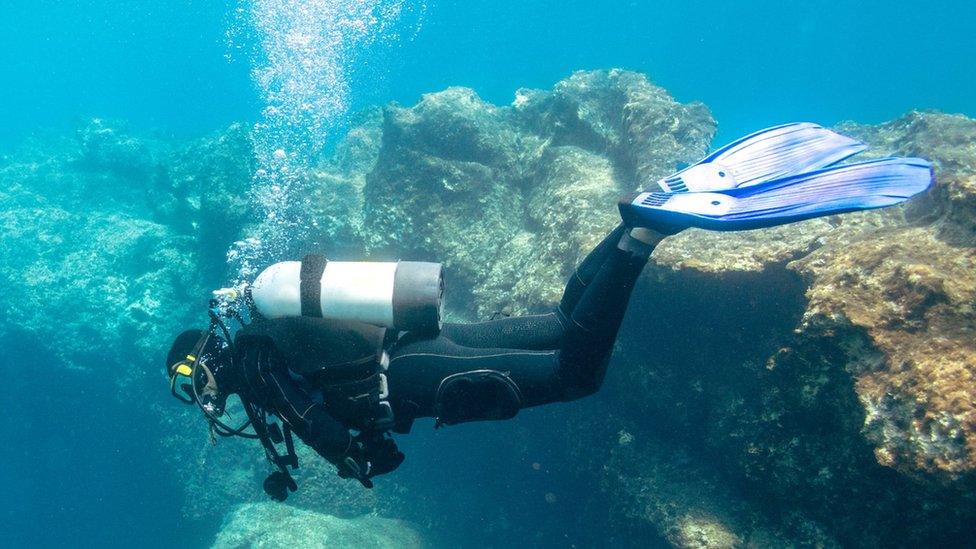How our cells sense oxygen wins Nobel prize
- Published

Three scientists who discovered how cells sense and adapt to oxygen levels have won the 2019 Nobel Prize.
Sir Peter Ratcliffe, of the University of Oxford and Francis Crick Institute, William Kaelin, of Harvard, and Gregg Semenza, of Johns Hopkins University share the physiology or medicine prize.
Their work is leading to new treatments for anaemia and even cancer.
The role of oxygen-sensing is also being investigated in diseases from heart failure to chronic lung disease.
Sir Peter said: "I'm honoured and delighted at the news.
"It's a tribute to the lab, to those who helped me set it up and worked with me on the project over the years, to many others in the field, and not least to my family for their forbearance of all the up and downs."

William Kaelin, Sir Peter Ratcliffe and Gregg Semenza
The Swedish Academy, which awards the prize, said: "The fundamental importance of oxygen has been understood for centuries but how cells adapt to changes in levels of oxygen has long been unknown."
Oxygen levels vary in the body, particularly:
during exercise
at high altitude
after a wound disrupts the blood supply
And when they drop, cells rapidly have to adapt their metabolism.
Why does this matter?
The oxygen-sensing ability of the body has a role in the immune system and the earliest stages of development inside the womb.
If oxygen levels are low, it can trigger the production of red blood cells or the construction of blood vessels to remedy this.
More red blood cells mean the body is able to carry more oxygen and is why athletes train at altitude.
So, drugs that mimic it may be an effective treatment for anaemia.
Tumours, meanwhile, can hijack this process to selfishly create new blood vessels and grow.
So, drugs that reverse it may help halt cancer.
"The work of these three scientists and their teams has paved the way to a greater understanding of these common, life-threatening conditions and new strategies to treat them," Dr Andrew Murray, from the University of Cambridge, said.
"Congratulations to the three new Nobel Laureates. This is richly deserved."
How do you they pick a Nobel prize winner?
How was the discovery made?
Levels of hormone erythropoietin (EPO) were shown to rise as those of oxygen fell.
And the scientists discovered this was because a cluster of proteins called hypoxia-inducible factor (HIF) was changing the behaviour of DNA, the genetic code.
Further work showed when oxygen levels were normal, cells constantly produced HIF only for it to be destroyed by another protein, VHL.
But when oxygen levels fell, VHL could no longer stick to HIF, leading to the build-up sufficient levels to change the behaviour of DNA.

Previous winners
2018 - James P Allison and Tasuku Honjo for discovering how to fight cancer using the body's immune system
2017- Jeffrey Hall, Michael Rosbash and Michael Young for unravelling how bodies keep a circadian rhythm or body clock
2016 - Yoshinori Ohsumi for discovering how cells remain healthy by recycling waste
2015 - William C Campbell, Satoshi Ōmura and Youyou Tu for anti-parasite drug discoveries
2014 - John O'Keefe, May-Britt Moser and Edvard Moser for discovering the brain's navigating system
2013 - James Rothman, Randy Schekman, and Thomas Sudhof for discovering how cells precisely transport material
2012 - John Gurdon and Shinya Yamanaka for changing adult cells into stem cells
2011 - Bruce Beutler, Jules Hoffmann and Ralph Steinman for revolutionising the understanding of how the body fights infection
2010 - Robert Edwards for devising the fertility treatment in vitro fertilisation (IVF), which led to the first "test-tube baby", in July 1978
2009 - Elizabeth Blackburn, Carol Greider and Jack Szostak for finding the telomeres at the ends of chromosomes, external